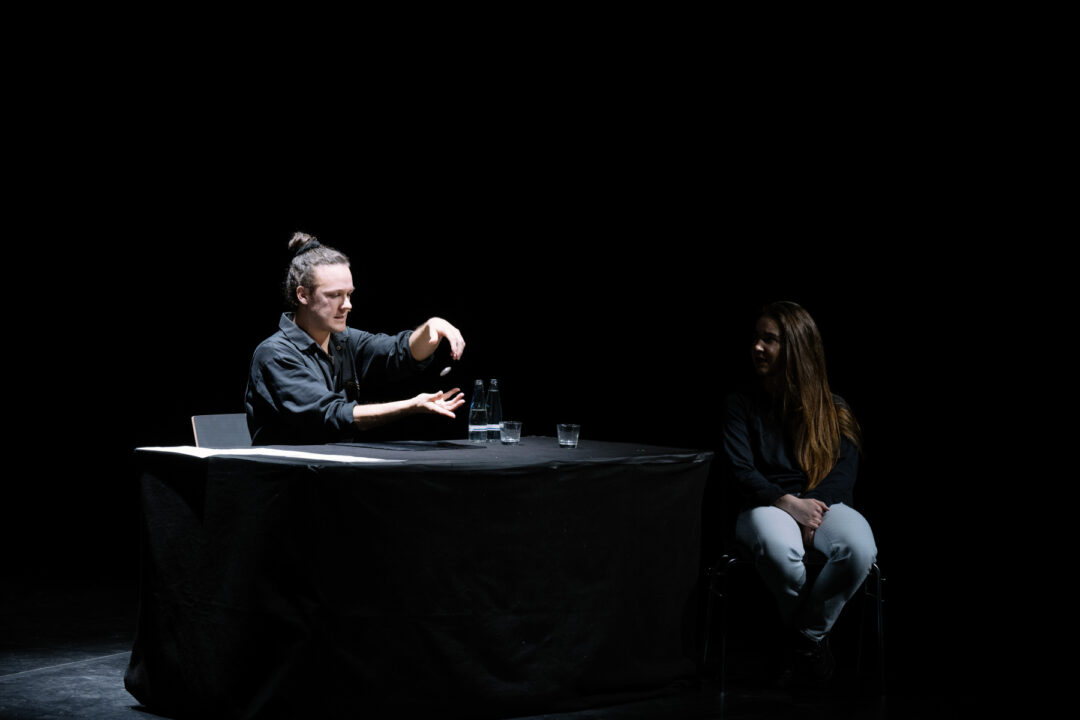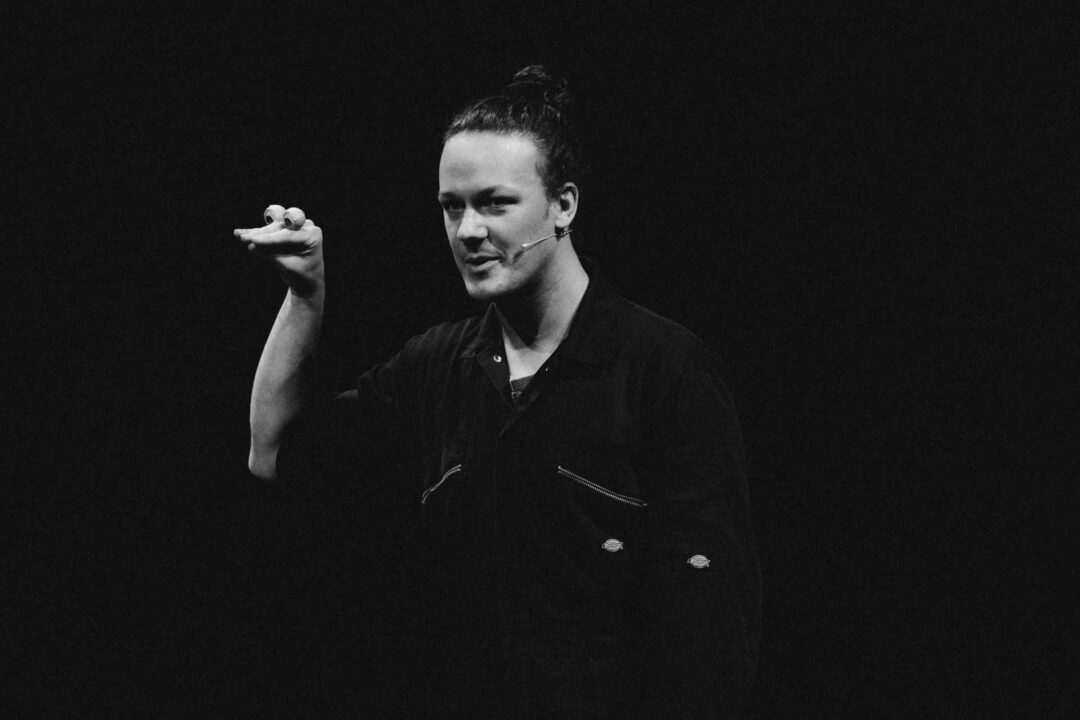Text by Ana Finel Honigman
Photos by Camille Blake

Text by Ana Finel Honigman
Photos by Camille Blake

Tom Cassani demonstrates Picasso’s dictum that “art is a lie to tell the truth.” Combining the banal with the wondrous while building from within overlapping traditions of art, performance, and illusion, Cassani’s (deceptively) humble presentation Expanded Magic makes his audiences mindful of suspending disbelief and escaping into moments of magic. Working in an era where objective truth is disputed and discredited, Cassani uses overt illusion to challenge audiences’ credulity. But don’t interpret his work as a statement about our cultural moment; Cassani doesn’t want his magic to be illustrative, acting as a metaphor, but instead to gracefully guide viewers to their own conclusions about truth and belief through the experience of participating in feats of wonder. As Socrates believed, wonder is where philosophy begins. In this spirit, Cassani uses wonder to conjure conversations about the nature of perception and call for a shared understanding of truth.
Playing with disinformation is part of the sideshow tradition. According to legend, Djedi, the first magician, reanimated a decapitated goose for the Pharaoh around 2,500 BCE. He placed the goose’s severed head at one end of a room and its body at the other, before speaking words that compelled the goose to its feet to walk the room until reconnected with its estranged head. This headless goose still roams popular histories of magic, but it originated from nineteenth-century promotional material announcing vaudeville magic acts.
Alongside this myth of magic’s origins is the assumption that audiences in bygone eras were always gullible and subject to deception, and by no means complicit in the process of creating a shared experience with the performer. Historical documents even demonstrate that some magicians were subjected to death because their illusions were believed to be evil or sacrilegious. Others, however, were appreciated as skilled entertainers who bent the rules of the natural world. Indeed, past audiences’ lenses blended religion, alchemy, and scientific exploration—just as we pick our echo chambers today.
When Hocus Pocus Junior: The Anatomie of Legerdemain, the first written guide to magic, was anonymously published in 1635, readers were shown the mechanisms of magic without dispelling any of its wonders. (In fact, the full title reads Hocus pocus junior: the anatomie of legerdemain, or, The art of jugling set forth in his proper colours, fully, plainly, and exactly, so that an ignorant person may thereby learn the full perfection of the same, after a little practice: unto each tricke is added the figure, where it is needfull for instruction.) Cassani works within this tradition, drawing attention to the marvel of someone building an illusion. The exciting element in his work isn’t only the outcome but the process, involving human intelligence, endurance, and dexterity.


By reminding audiences that magic and its myths are fantasies, Cassani promotes what he calls an “anti-theatrical fantastic,” wherein he draws attention to craft and intention instead of relying on deception. During a performance, he casually tells audiences how many years he required to master a trick while still demonstrating his mastery of something wondrous. But even intellectually understanding how a coin disappears in Cassani’s hands can’t dissolve the delight one feels when watching it actually happen.
Cassani’s deconstruction of performing illusions extends to the way he defines what he does. He does not see himself as a magician; he identifies instead as using illusion and practices of deception while “acknowledging that [being a magician] is a thing in the world, but I do something to one side of that.”
There’s a meta performance to every act: he explicitly pairs classic sideshow practices that he performs as himself, an artist, with ways of performing the same action “as a magician,” to spotlight the contrivances and expectations associated with the history of magic. When performing a coin trick, he’ll do it once, as himself, and then again as a “magician” to ask audiences to repeatedly opt into the process of being tricked and become conscious of the moment they agree to follow him into the illusion. Cassani resists adopting an authoritative stance by dressing in everyday clothes or reading from written statements, thereby subverting the central illusion in traditional magic: that the performer is super-human.
Blessed, according to their mythos, with otherworldly gifts that defy accessible reality, magicians historically existed in a risky zone between religion, science, and entertainment. To maintain balance, the hierarchy between audience and performer in traditional magic is clear and rigid. The illusionist’s allure is their expectational relationship with forces outside the natural world, whereas Cassani’s great trick is evoking empathy and collaboration in his audiences. “I have a body,” he says, “and they have a body—although my body can do stuff that it seems like it shouldn’t be able to do.” The body and its intrinsic limitations are the core playing field for magic. Even when the magical event appears to happen outside the magician, the performer’s presence is portrayed as the conduit between reality and something extraordinary. Cassani, whose performances combine classic sleight of hand with acrobatics, is both object and subject of recognizable forms of corporal magic. If a coin disappears in his hands, his body seems to create the effect, but if he’s dangling by his hair from great heights, his body becomes the very site of disbelief. In both instances, viewers are forced to remember that their bodies likely have no such experiences.
Like dance or sport, fans of magic measure their bodies’ abilities against those of the performer and viscerally feel this contrast when watching someone defy their physical limits. In this tradition, Cassani describes himself as interested in how the body in performance acts as a “measure of truth or vector of impossibility.”
By appearing to place himself in vulnerable situations, he and his audience collaborate to create the illusion of danger and the experience of surviving a shared event. He sees his audience as “participating in the performance of that vulnerable situation as much as I am.” Cassani takes his viewers to the brink of disbelief in this process, but ensures they remain conscious of the mechanisms of their own involvement while still retaining a sense of awe and excitement. “If I was just doing these tricks in my bedroom, they wouldn’t be magic. It would just be me fiddling with something in my bedroom. But the moment that I perform for an audience, it becomes another thing, and I acknowledge that relationship.”
You are currently viewing a placeholder content from Facebook. To access the actual content, click the button below. Please note that doing so will share data with third-party providers.
More InformationYou need to load content from reCAPTCHA to submit the form. Please note that doing so will share data with third-party providers.
More InformationYou are currently viewing a placeholder content from Instagram. To access the actual content, click the button below. Please note that doing so will share data with third-party providers.
More InformationYou are currently viewing a placeholder content from Instagram. To access the actual content, click the button below. Please note that doing so will share data with third-party providers.
More InformationYou are currently viewing a placeholder content from X. To access the actual content, click the button below. Please note that doing so will share data with third-party providers.
More Information